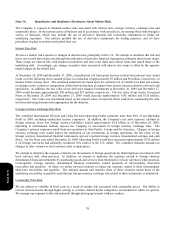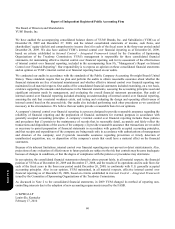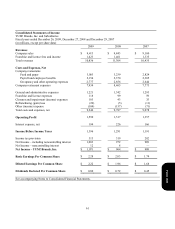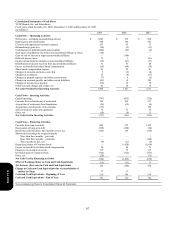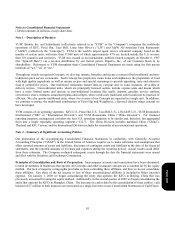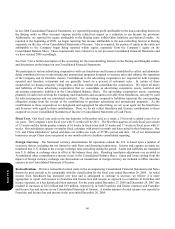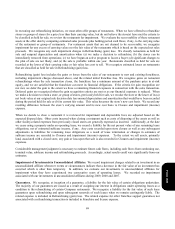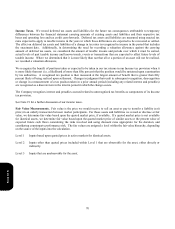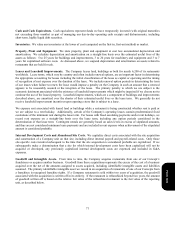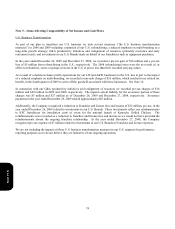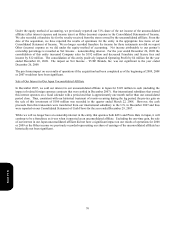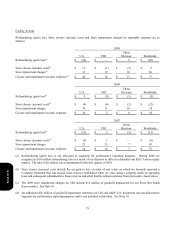Pizza Hut 2009 Annual Report Download - page 159
Download and view the complete annual report
Please find page 159 of the 2009 Pizza Hut annual report below. You can navigate through the pages in the report by either clicking on the pages listed below, or by using the keyword search tool below to find specific information within the annual report.
68
Direct Marketing Costs. We charge direct marketing costs to expense ratably in relation to revenues over the year in
which incurred and, in the case of advertising production costs, in the year the advertisement is first shown. Deferred
direct marketing costs, which are classified as prepaid expenses, consist of media and related advertising production costs
which will generally be used for the first time in the next fiscal year and have historically not been significant. To the
extent we participate in advertising cooperatives, we expense our contributions as incurred. Our advertising expenses
were $548 million, $584 million and $556 million in 2009, 2008 and 2007, respectively. We report substantially all of
our direct marketing costs in Occupancy and other operating expenses.
Research and Development Expenses. Research and development expenses, which we expense as incurred, are reported
in G&A expenses. Research and development expenses were $31 million, $34 million and $39 million in 2009, 2008 and
2007, respectively.
Share-Based Employee Compensation. We recognize all share-based payments to employees, including grants of
employee stock options and stock appreciation rights (“SARs”), in the financial statements as compensation cost over the
service period based on their fair value on the date of grant. This compensation cost is recognized over the service period
on a straight-line basis for the fair value of awards that actually vest. We report this compensation cost consistent with the
other compensation costs for the employee recipient in either Payroll and employee benefits or G&A expenses.
Impairment or Disposal of Property, Plant and Equipment. Property, plant and equipment (“PP&E”) is tested for
impairment whenever events or changes in circumstances indicate that the carrying value of the assets may not be
recoverable. The assets are not recoverable if their carrying value is less than the undiscounted cash flows we expect to
generate from such assets. If the assets are not deemed to be recoverable, impairment is measured based on the excess of
their carrying value over their fair value.
For purposes of impairment testing for PP&E, we have concluded that an individual restaurant is the lowest level of cash
flows unless our intent is to refranchise restaurants as a group. We review our long-lived assets of restaurants (primarily
PP&E and allocated intangible assets subject to amortization) that are currently operating and have not been offered for
refranchise semi-annually for impairment, or whenever events or changes in circumstances indicate that the carrying
amount of a restaurant may not be recoverable. We use two consecutive years of operating losses as our primary indicator
of potential impairment for our semi-annual impairment testing of these restaurant assets. We evaluate the recoverability
of these restaurant assets by comparing the estimated undiscounted future cash flows, which are based on our entity
specific assumptions, to the carrying value of such assets. For restaurant assets that are not deemed to be recoverable, we
write down an impaired restaurant to its estimated fair value, which becomes its new cost basis. Fair value is an estimate
of the price a franchisee would pay for the restaurant and its related assets and is determined by discounting the estimated
future after-tax cash flows of the restaurant. The after-tax cash flows incorporate reasonable assumptions we believe a
franchisee would make such as sale growth and margin improvement. The discount rate used in the fair value calculation
is our estimate of the required rate of return that a franchisee would expect to receive when purchasing a similar restaurant
and the related long-lived assets. The discount rate incorporates rates of returns for historical refranchising market
transactions and is commensurate with the risks and uncertainty inherent in the forecasted cash flows.
Form 10-K


